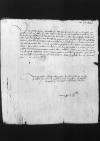Letter #5020
Albrecht I von Hohenzollern-Ansbach to Ioannes DANTISCUSKönigsberg, 1541-03-24
| received Heilsberg (Lidzbark Warmiński), 1541-03-26 Manuscript sources:
Prints:
| ||||||||
Text & apparatus & commentaryPlain textText & commentaryText & apparatus
Dem erwirdigenn inn Gott unnserm besonndernn liebenn Freundt / unnd nachparnn, / herrnn
Unnser freuntlich dinnst zuvor.
Erwirdiger inn Gott besonnder lieber freunndt / unnd nachbar. /
Wir zweÿfelenn nicht E(uer) L(ieb) habenn inn unserm gethanenn schreibenn / aus was mergklicher vorhinderung / wir die unnsernn zu besichtigung des mulbaus des erenvestenn unnsers obermarschalchs, / raths unnd liebenn getreuenn
Dat(um)
Vonn Gots gnadenn


 BCz, 1606, p. 558
BCz, 1606, p. 558